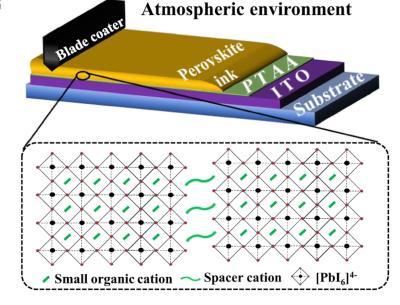Researchers from China's National Center for Nanoscience and Technology, Chinese Academy of Sciences (CAS) and Beihang University have demonstrated a series of ultrastable Dion−Jacobson (DJ) perovskites for photovoltaic applications. They went on to develop a 2D Dion-Jacobson (DJ) perovskite solar cell that showed high stability while achieving a power conversion efficiency of 19.11%.
Schematic illustration of the blade-coating film and the corresponding device configuration under atmospheric environment at room temperature. Image credit: Nature Communications
Two-dimensional (2D) Dion-Jacobson (DJ) phase perovskites have drawn attention from academia due to their stability against harsh environmental conditions and their competitive performance in optoelectronic applications. Solar cells based on DJ perovskites, however, have so far shown comparatively poor performance compared to their 3D counterparts.
For the solar cell, the research group utilized a perovskite material known as (CDMA)(MA)n−1PbnI3n+1, where CDMA stands for 1,4-cyclohexanedimethanammonium. “Structural analyses show that these materials have an extraordinarily slight interlayer-displacement quantum-well configuration that differs from most DJ perovskites, which can reduce interlayer spaces and tune their mutual alignment to facilitate interlayer charge transport and structural stability,” said the researchers.
The device was fabricated using blade coating technology and is said to be scalable. It was designed with a substrate made of glass and indium tin oxide (ITO), a hole transport layer (HTL) based on poly[bis(4-phenyl)(2,5,6-trimethylphenyl)amine (PTAA), CDMA-based DJ perovskite layer, a buckminsterfullerene (C60) electron transport layer (ETL), a bathocuproine (BCP) buffer layer, and a top electrode made of silver (Ag).
For reference, the group also created a similar cell with a change in the DJ perovskite layer. Whereas the novel structure was based on CDMA, the reference cell was based on PDMA, which stands for 1,4-phenylenedimethanammonium. PDMA DJ has a similar organic molecular configuration to CDMA materials, but they have been more widely studied.
Tested under standard illumination conditions, the CDMA DJ cell achieved an efficiency of 19.11%, an open-circuit voltage of 1.16 V, a short-circuit current density of 20.41 mA cm−2, and a fill factor of 80.56%. The reference PDMA DJ device obtained an efficiency of 14.87%, an open-circuit voltage of 1.06 V, a short-circuit current density of 18.32 mA cm−2, and a fill factor of 76.46%.
“Importantly, fabricated cells also exhibit remarkable humidity, thermal, and operational stability,” said the team. “After keeping them in a 90% relative humidity (RH) or 85 C continuous aging condition for over 4000 h and 5000 h, respectively, the devices show an 8% degradation for the humidity stability test and negligible efficiency loss for thermal stability measurement. Particularly, the operational stability under continuous light stress shows negligible efficiency loss exceeding 6000 h.”
The scientists added that “the designed interlayer-displacement DJ series provides a significant and potential pathway for constructing new structurally stable 2D perovskites. The blade-coating application of the designed DJ perovskite solar cells might spur new developments in scalable technology and their commercialization process.”




